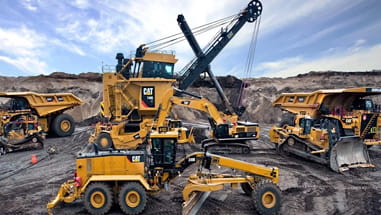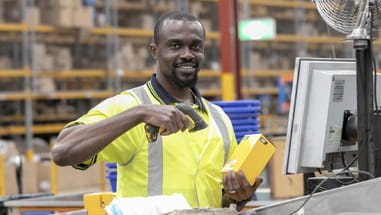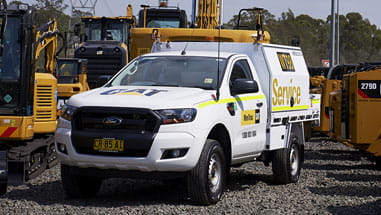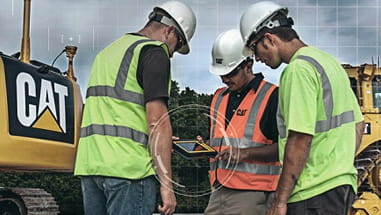With our huge inventory of new, used and rental equipment, WesTrac has the right machine for the job.
In a world-first for autonomous drilling, mining services provider Thiess has successfully rolled out a system that involves three Cat® drill rigs being remotely operated by a single operator.
6 September 2022
In a world-first for autonomous drilling, mining services provider Thiess has successfully rolled out a system that involves three Cat® drill rigs being remotely operated by a single operator.
The solution is part of an ongoing program, also involving original equipment manufacturer Caterpillar® and specialist Cat equipment and service provider WesTrac, to ultimately achieve full autonomy. The current solution involves a single operator, working from a remote onsite operating centre, issuing commands to the three drill rigs simultaneously to instruct them to commence single-row autonomous drilling.
Apart from the operator instructing the rigs to move to the next row and commence drilling according to the pre-defined pattern, all operations are carried out using Cat autonomous technology. Ultimately, the program will see drill rigs completing entire drill patterns across multiple rows in fully autonomous mode.
Since the program went live earlier this year, Thiess has reported a 20 per cent improvement in drilling performance, including increased rig utilisation with operating times above 20 hours per drill per day. Accuracy has also improved with no redrilling required since the solution was rolled out.
According to WesTrac Project Manager Joanne Henry, the project involved an iterative rollout and collaborative approach between Thiess, WesTrac and Caterpillar that included phased development and implementation of various new technologies.
"As the OEM, Caterpillar developed the drills and the technology layer to a certain point, but as a development partner, Thiess drove a lot of the requirements for ongoing improvements and there’s been constant collaboration throughout the project,” Joanne said.
The phased approach allowed Thiess to progressively upskill workers, verify the technology in stages and move smoothly towards the desired final outcome.
Starting with a single drill rig and staged implementation of technology, Thiess progressed from manual operation to Operator Mission Assist (OMA) functionality that still involved an operator being stationed in the cab but introduced a range of automated functions. This allowed operators to build their understanding of new functions before the next stage – removing them from the cab and locating them in the remote operating station – was implemented.
Following successful evaluation of the single rig operating in autonomous mode, a second rig, albeit a different size to the first – was fitted with the same autonomous operating technology and Thiess operators were able to simultaneously control both rigs. A third rig was fitted out with the technology earlier this year, enabling Thiess to have three rigs working in unison.
According to Thiess, there were multiple benefits in relocating operators from the cab to the remote station. The obvious one was reduced risk by taking those operators “out of the line of fire”, however improved fatigue management also occurred as operators were freer to take short breaks and move around without impacting drill operations.
“Thiess also realised a higher level of engagement because team members had the opportunity to upskill,” Joanne said.
“That has the potential not only to drive retention of existing staff, but to attract younger generations who see the appeal of working with world-leading technology.”
Another beneficial outcome derived from the collaborative approach was the development of new strata visualisation software that allows operators to see a 3D view of each hole profile they have drilled.
“That’s another piece of technology that in itself could revolutionise the way drilling operations are carried out,” Joanne said.
“But more importantly, it is a powerful addition to the overall solution that’s enabling Thiess to realise significant people, technology and process benefits.”
Authorised Images
WesTrac Media Contact
Spoke
Marissa Taddeo
marissa@hellospoke.com.au
0401 019 885
Emily Evans
emily@hellospoke.com.au
0401 337 959
About thiess
Thiess works with clients in Australia, Asia and the Americas in the dynamic field of open-cut and underground mining. At our core is the pioneering spirit of the legendary Thiess brothers. Their vision defined firsts, unlocked possibilities and found smarter ways to scale what mattered to society. More than 85 years on, their story is still in the Thiess DNA.About WesTrac
As one of the largest authorised Cat equipment dealers in the world, WesTrac provides customers with a wide range of mining and construction equipment as well as comprehensive whole-of-life management solutions designed to make owning and operating equipment as easy, profitable and safe as possible. With more than 4,500 staff, WesTrac is focused on long-term customer relationships and a dedication to customer service, safety, quality and the environment.
To achieve this, we commit to building better together through collaboration and collective action. Helping customers achieve their own ESG objectives to reduce emissions through product advancements and technology solutions. This shared goal of a sustainable future for all is why we are focused on Responsibility, Advancement, Community, Inclusivity, Development and Solutions, as a means to deliver long-term positive success for the environment, customers, team members, stakeholders and the wider community.
Community development and support is an important part of the WesTrac philosophy, and we are proud to support local activities, events and charities in the regions we are based. As part of SGH Ltd, WesTrac also has strong alliances with other leading Australian businesses, including Seven West Media, Boral, Coates and SITECH.
Mining White Paper
Targeting Zero Emissions in Mining
Mining is subject to a range of regulations and public scrutiny when it comes to improving sustainability. There are no specific metrics to identify just how far miners need to go – but as this whitepaper discusses, it is a process of continual improvement, and stakeholders at every stage in the supply chain have a role to play.





